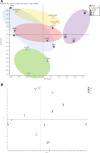Deciphering glycomics and neuroproteomic alterations in experimental traumatic brain injury: Comparative analysis of aspirin and clopidogrel treatment
- PMID: 27249377
- PMCID: PMC4963819
- DOI: 10.1002/elps.201500583
Deciphering glycomics and neuroproteomic alterations in experimental traumatic brain injury: Comparative analysis of aspirin and clopidogrel treatment
Abstract
As populations age, the number of patients sustaining traumatic brain injury (TBI) and concomitantly receiving preinjury antiplatelet therapy such as aspirin (ASA) and clopidogrel (CLOP) is rising. These drugs have been linked with unfavorable clinical outcomes following TBI, where the exact mechanism(s) involved are still unknown. In this novel work, we aimed to identify and compare the altered proteome profile imposed by ASA and CLOP when administered alone or in combination, prior to experimental TBI. Furthermore, we assessed differential glycosylation PTM patterns following experimental controlled cortical impact model of TBI, ASA, CLOP, and ASA + CLOP. Ipsilateral cortical brain tissues were harvested 48 h postinjury and were analyzed using an advanced neuroproteomics LC-MS/MS platform to assess proteomic and glycoproteins alterations. Of interest, differential proteins pertaining to each group (22 in TBI, 41 in TBI + ASA, 44 in TBI + CLOP, and 34 in TBI + ASA + CLOP) were revealed. Advanced bioinformatics/systems biology and clustering analyses were performed to evaluate biological networks and protein interaction maps illustrating molecular pathways involved in the experimental conditions. Results have indicated that proteins involved in neuroprotective cellular pathways were upregulated in the ASA and CLOP groups when given separately. However, ASA + CLOP administration revealed enrichment in biological pathways relevant to inflammation and proinjury mechanisms. Moreover, results showed differential upregulation of glycoproteins levels in the sialylated N-glycans PTMs that can be implicated in pathological changes. Omics data obtained have provided molecular insights of the underlying mechanisms that can be translated into clinical bedside settings.
Keywords: Aspirin; Clopidogrel; Neuroproteomics; PTMs; TBI.
© 2016 WILEY-VCH Verlag GmbH & Co. KGaA, Weinheim.
Conflict of interest statement
The authors declare no conflict of interest.
Figures



Similar articles
-
The effect of clopidogrel and aspirin on the severity of traumatic brain injury in a rat model.Neurochem Int. 2022 Mar;154:105301. doi: 10.1016/j.neuint.2022.105301. Epub 2022 Feb 2. Neurochem Int. 2022. PMID: 35121011
-
Initial experience with dual antiplatelet thromboprophylaxis using clopidogrel and aspirin in patients with mechanical aortic prostheses.J Heart Valve Dis. 2009 Nov;18(6):617-25; discussion 626. J Heart Valve Dis. 2009. PMID: 20099710
-
Managing PAD with multiple platelet inhibitors: the effect of combination therapy on bleeding time.J Vasc Surg. 2003 Oct;38(4):710-3. doi: 10.1016/s0741-5214(03)01029-2. J Vasc Surg. 2003. PMID: 14560218 Clinical Trial.
-
Possible mechanisms of drug-induced aspirin and clopidogrel resistance.J Thromb Thrombolysis. 2006 Oct;22(2):139-50. doi: 10.1007/s11239-006-8670-y. J Thromb Thrombolysis. 2006. PMID: 17008981 Review.
-
The role of clopidogrel in the management of acute coronary syndromes.Clin Ther. 2003 Aug;25(8):2155-81. doi: 10.1016/s0149-2918(03)80211-4. Clin Ther. 2003. PMID: 14512126 Review.
Cited by
-
Isomeric Separation of N-Glycopeptides Derived from Glycoproteins by Porous Graphitic Carbon (PGC) LC-MS/MS.Anal Chem. 2020 Jul 21;92(14):9556-9565. doi: 10.1021/acs.analchem.0c00668. Epub 2020 Jul 6. Anal Chem. 2020. PMID: 32544320 Free PMC article.
-
The dynamic brain N-glycome.Glycoconj J. 2022 Jun;39(3):443-471. doi: 10.1007/s10719-022-10055-x. Epub 2022 Mar 25. Glycoconj J. 2022. PMID: 35334027 Review.
-
Neuroproteomics and Systems Biology Approach to Identify Temporal Biomarker Changes Post Experimental Traumatic Brain Injury in Rats.Front Neurol. 2016 Nov 22;7:198. doi: 10.3389/fneur.2016.00198. eCollection 2016. Front Neurol. 2016. PMID: 27920753 Free PMC article.
-
Preventive Effects of Neuroprotective Agents in a Neonatal Rat of Photothrombotic Stroke Model.Int J Mol Sci. 2020 May 24;21(10):3703. doi: 10.3390/ijms21103703. Int J Mol Sci. 2020. PMID: 32456353 Free PMC article.
-
The Neuroprotective Effects of Phenolic Acids: Molecular Mechanism of Action.Nutrients. 2017 May 10;9(5):477. doi: 10.3390/nu9050477. Nutrients. 2017. PMID: 28489058 Free PMC article. Review.
References
-
- Ahmed N, Bialowas C, Kuo YH, Zawodniak L. South Med J. 2009;102:476–480. - PubMed
Publication types
MeSH terms
Substances
Grants and funding
LinkOut - more resources
Full Text Sources
Other Literature Sources
Medical
Research Materials
Miscellaneous

